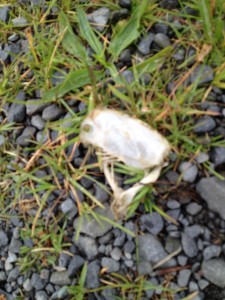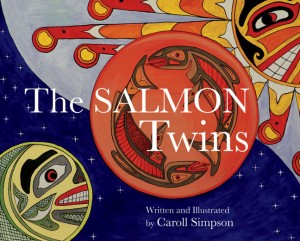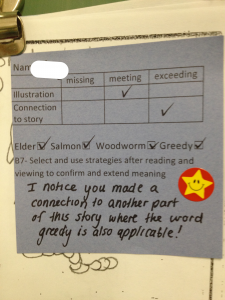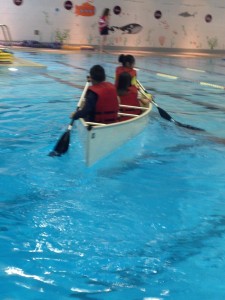On our nature walk one of my students saw this bone and wanted to take a picture of it. We’re very curious to find out what kind of animal it came from and how it got there…
Monthly Archives: April 2015
The Salmon Twins…
The Salmon Twins is quickly becoming one of my favourite books. This book is beautifully illustrated and weaves together legends and traditions from many Coast Salish First Peoples. The first time I read this book with the students it felt a bit rushed. I chose to read it last monday, the same day we went on a field trip to the salmon hatchery. I read this book aloud using the document camera.
The students loved the book but field trip days are busy and when we don’t leave first thing in the morning I find the students are really distracted by their anticipation. After reading the book I immediately regretted having the students at their desks instead of our comfy gathering area on the carpet. The students all successfully identified important characters in the text but we didn’t quite get to the deep thinking I had in mind.
On the Wednesday I attended a workshop presented by Faye Brownlie on CR4YR. This was just in time. I was inspired to try this book again with the class. Through that workshop I was able to touch base and return to all the ideas I knew about effective literacy practices and pick up some new ideas too. I was reminded of all the usual strategies that I’ve used before to engage primary students in shared reading and read aloud. I thought it was worth going back to those strategies, even with intermediate students. At the workshop I sat with a teacher who was my advisor for my third year practicum. When I was chatting with her she reminded me of all the things I did with her class that she thought were really strong and effective strategies. Being around her really lifted my spirits. She’s been teaching for more years than I’ve been alive and she still comes out to Pro D events in the evenings. It just goes to show you can always pick up something new, and if you already know something it doesn’t hurt to hear it again.
The very next day, Thursday morning I gathered the students at the bleachers for a think aloud about the book. I chose one page and told the students that we were going to do something different and we were all going to ask one question. Everyone had to come up with one question about what they saw on just that one page. We also were going to resist the temptation to try and answer any of those questions! I reiterated the importance of listening to each other’s questions since that might make us change our thinking. I reviewed that questions can usually start with who, what, why, where, when, how come, etc. and that your voice goes up at the end of a question. I gave the students some time to think and then we all shared our questions one at a time. Once everyone had asked at least one question only then did I allow some of the keen students to ask a second question (I picked this up from the workshop!). After we had each asked at least one question I finally read the text on that page. We then identified an interesting character and used the glossary of the book to help our understanding.
We then identified four key vocabulary terms from just that one page: Elder, Salmon, Greedy and Woodworm. I set out that my only criteria for the written response was that you use those four words in someway to show your understanding. I told the students that when they had a plan of what they were going to write they could quickly signal to me with their hand and I would give them the nod that they were ready to go back to their desk to write and illustrate. I told the students that if they didn’t have a plan yet they could stay at the carpet space to chat with me. I am really enjoying this strategy… it is really increasing our productivity- no one leaves the carpet without a plan! This allows me to “catch” everyone who needs my attention and no one is getting lost in the physical space of the classroom. Students who are not yet ready to begin working independently can choose to stay and talk to me until they feel ready. The work output was impressive. Some students completed more than one page and the illustrations were wonderful.
I followed up on Monday to let the students know I had read their work and responded. I kept my assessment simple but meaningful. The main goal for me was to show students that I was looking at their work and listening to their ideas. Another teacher at the school mentioned to me that her philosophy for assessment is all about quick turn around and timely feedback for students. I printed my little checklist onto sticky notes and got to it!
Today I revisited the book at the carpet space to introduce a new thinking routine “Circle of Viewpoints”. We used “I feel” statements to identify what the characters may be thinking at different parts of the stories.
Here’s an example:
Viewpoint: “I feel sad because I miss the twins”
Character: Grandma
The students really had fun with this one. We said the viewpoint and then allowed others to guess who the character was. It kind of felt like a bit of a game! We also talked about how “I” statements can be used to be respectful when we have disagreements with others. This thinking routine may be a keeper just like our compass routine.
It’s funny… it was a rocky start and I didn’t know that this story would capture the student’s attention for so long (or mine!). It’s been a wonderful interlude connecting our science unit about salmon to beginning deeper investigation, understanding and appreciation of Canada’s first peoples.
Did I participate in too many pro-d activities this week?
This week was very busy… on top of the usual happenings of our class (field trips! tea parties! birthdays! projects! assemblies!) I ended up attending numerous professional development activities…
Tuesday Math– In the morning I attended a workshop about differentiated instruction in math with my school advisor and other intermediate teachers. With a class as diverse as ours all of the ideas the speaker was sharing seemed highly relevant. I found her presentation style to be very engaging too. An idea she mentioned that I really agree with is that we shouldn’t rush students along to abstract thinking too quickly! The concrete demonstrations that can be achieved through rich problems and manipulatives do not water down the math learning, they only enhance it. I loved the cuisenaire rods she uses to teach fractions. They are beautiful materials!
Wednesday Literacy– On Wednesday I went to an evening workshop on Changing Results For Young Readers (CR4YR). Faye Brownlie was amazing, she does such as good job of modelling the strategies she teaches. I was able to use some of the ideas from her workshop the very next morning with a book called Salmon Twins, a simple read aloud that I was able to revisit in a very rich inquiry minded way after this workshop. The LST from our school just happened to observe this lesson and even she was impressed! Some of the content from the workshop was a refresher for me on strategies I already knew and some ideas were brand new to me. I knew enough that I didn’t feel lost but had enough to learn to keep it interesting! This workshop was so good I would honestly attend it again. As an intermediate teacher I’ve been finding my background in literacy research and intervention to be much more valuable and applicable than I expected. Intermediate classes have a range of readers from primary to high school!
Thursday More Math!– Thursday after school was a small workshop on division for intermediate teachers with the district’s math coordinator. She was very nice. I really appreciated her perspective on algorithms. Some teachers still choose to use them but I felt like she gave me a lot of other options.
Friday District Pro D, Aboriginal Education– Friday was District Pro D at the Longhouse. I learned more about coast salish culture and the whole experience was very interesting. The workshop was really powerful. At one point hearing from a survivor of a residential school was difficult. Being in the longhouse made me feel like I was part of a community of learners who were brought together to make a commitment to contributing to truth and reconciliation. Our part is to try and understand and incorporate aboriginal knowledge, culture and ways of knowing. Our part is also to support young people so they can be leaders of the community. I also got a chance to briefly meet the district Aboriginal Curriculum Implementation Mentor Teacher. She is coming to my school next week to meet with me about the language arts and social studies unit I have coming up.
Spring Cleaning and Organizing Project Based Learning
Something I have found challenging so far during this practicum is the organization of the physical space of the classroom. The class is a unique challenge because almost all the learning every day is project based. At any given time we may have 2-3 projects happening simultaneously.
Keeping the space clean and organized is a big priority for me this term.
Here are some simple strategies I’ve put into place to get organized
- File folder- I have a file folder with one section for every student in the class where I keep completed work, documentation and evidence of learning that I intend to use for assessment
- New attendance system – picture based and student directed. When you come in during the morning, put your face in the basket to let me know you are here! The students love it, they find it hilarious.
- Visuals on the board to indicate progress. I have devised a simple system using magnets of the student’s names and tape. The students indicate where in a project they are so I know when I can move on to teaching the next thing.
This upcoming week I will be taking my spring cleaning craze to the next level. I’ve been driving around my car today to look for good condition items on the curb that can help organize the class.
- One desk group has been having some conflicts over loose papers piling up and making a mess. After meeting with the group our simple agreed upon solution is to have a basket at the desk for the four students to put their recycling in. I found a suitable basket this weekend at the thrift store. We’ve planned to meet again at the end of this week so I’ll see how it works.
- I have picked a basket for planners from some of the things one of my neighbours put out. Starting this week students will leave their planners in a basket by the bleachers in order to expedite writing in our planners at the end of the day to give us more time for working on all our projects and getting them cleaned up!
- Lemon and vinegar inquiry… All week I have had a jar full of vinegar, water, half a grapefruit peel and half a lemon peel on one of the tables in the classroom. I have set it up as a provocation, something I’ve been learning through my reggio inquiry. Students have many speculations about it… Some think that there are pears inside. Some students think I am making lemon aid. Many students think it is something I’m going to use for science fair. I will be adding a plastic spray bottle to this provocation to see if I can nudge students thinking towards making our own cleaners for the classroom. If this is a topic students become interested in it will fit perfectly with our study of measurement.
Water safety
We had our water safety course today at the pool. This was a wonderful field trip. Safety is a big theme in our classroom right now. It’s part of our health and career outcomes but it’s also part of our responsibilities as people who live near the water and as a caring classroom community. In our community it’s especially important to learn about water safety. Very recently there was some upsetting news in the media about the death of an elderly man in our community who passed away in the river.
We were able to have a meaningful and age appropriate conversation about the sad news that was very close to home for us. I noticed that although all the students were having fun and enjoying themselves, they were also taking the learning happening very seriously.
We learned about
-conserving body heat when in the water
-what should come on boats and what should stay on the shore
-CPR using chest compressions only
-Canoe safety
-floatation devices
and a lot more!
What was interesting for me was seeing the students in another learning environment. The wonderful staff and lifeguards are educators but not necessarily teachers. In this environment there isn’t a lot of modification or adaptations of activities. There are no IEPs and the instructors and the students don’t have any history together. It was interesting to see how the lifeguards interacted with the students. For a few students it was shocking, although no one reacted overtly negatively. It was just for one afternoon, a bit eye opening for me. I was able to watch the students react to a style very different from my own!
Interesting fact: when I was a student they used to teach you to do chest compressions to the tune of “staying alive”. Now they teach students chest compressions using “Uptown Funk”.
April 1st, Random Acts Of Kindness Day
I was very nervous about April Fools Day looming on the third day back from Spring Break. I was worried that some of the students in the class would think it was funny to do ‘pranks’. I don’t like pranks- they don’t really fit in with our classroom guidelines of take care of yourself, take care of others and take care of this place. I did a short lesson the day before April 1 about “The Smile Lady” to introduce the idea of Random Acts of Kindness. We created a venn diagram comparing pranks and RAKs. Our class found that pranks mostly embarrassed people or created a mess. RAKs however filled buckets, made people smile and made people feel appreciated. What pranks and RAKs have in common is that they can both be unexpected and spontaneous.
This really helped me redirect some of the energy the students had. We spent a little bit of time creating proposals for RAKs. Some people chose to work alone and some people chose to team up with someone else in the class. Every person submitted an idea and had it approved by me. I set up a couple basic rules for RAKing someone
– the RAK should not embarrass the person
– the RAK should not create a mess
– the RAK should cost very little to no money
– the RAK should not disturb anyone during school time
I loved the creativity that followed… I could not stop smiling. Some people left short anonymous notes with kind compliments on them. Some people cleaned the classroom. Someone chose to put a tablecloth on the bleachers and prepare a nice snack for the class. The day was full of kind surprises for those in our class and around the school. We even RAKed an entire class together as a team! The best part was that the RAKs actually continued the day after as well- the students in the class have found that doing nice things for others (even if it’s something small) feels incredibly rewarding!
I’m proud to say that not one person from my class did any pranks this April Fools day.



